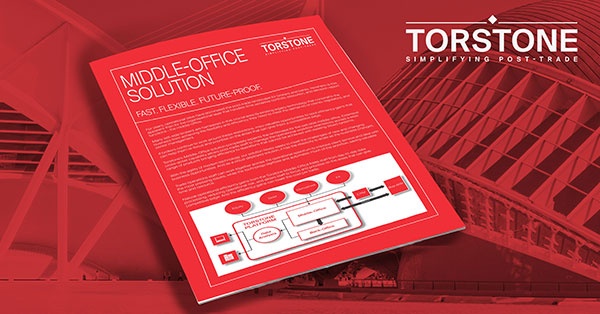Regulatory compliance and new demands on post-trade operations have long pointed to the benefits of streamlining processes in the middle and back office. This year, new market initiatives and developments (T+1 and growth in digital assets) are adding to existing pressure to ensure integration between the middle and back-office operations is automated and efficient. In a Q&A with Brian Collings, CEO, Torstone Technology, we explore the importance of post-trade processing integration in 2022 and the role of data in achieving a seamless end-to-end operation that meets current regulatory requirements and future needs.
Q. The integration of middle and back-office processes has long been a goal for many financial institutions. Why is now the time for organisations to really focus on achieving this goal?
A. The main driver is regulatory change. Moving to T+1 settlement, firms have to change the pace of what they are doing. There are certain middle-office functions that need to happen the same day as the trade in order to settle the following day. Connecting middle and back-office functioning therefore becomes imperative.
Fines for settlement failures are another regulatory change that impacts the front office. With tighter settlement timeframes, settlement failures have become an expensive problem that is impacting P&L directly. Historically, the middle office has been closely attached to the front office, but increasingly firms need a back-to-front flow of information. The front office requires back-office information to understand trends and issues around settlement fails. This enables the front office to see more in real time than ever before.
The other driver is the rise in demand for cryptocurrency and digital asset trading. Settlement for that is totally real time, seven days a week. While regulation can often get delayed, the digital assets space keeps the pressure on because firms need to move away from legacy back-office systems in order to jump on the crypto bandwagon.
Q. What are the main obstacles that firms face in integrating the pre- and post-trade operation or moving operational processes back to front?
A. Historically, the back office has been seen as a cost centre and has been very much underfunded. There are a lot of legacy systems that can’t adapt quickly, and they also tend to be siloed by asset class. One of the things we are seeing in the market is consolidation of equities and fixed income middle-office functions to improve efficiency. Historically they were siloed because they are more attached to the front office, which tended to be very asset class aligned. The consolidation of the middle and back-office functions across asset classes is the way to gain operational efficiencies that have been lacking. But one of the main obstacles is a lack of adaptable, cloud-based, real-time technology.
Recent high volatility, for example driven by the pandemic and the Russia-Ukraine war, has meant some firms have seen much higher daily volumes. Where systems are not cloud based or real time, they run into capacity issues, and it puts a lot of pressure on the legacy systems to be able to deal with sudden high volumes. Whereas cloud-based, on-demand environments can handle changing volumes more straightforwardly as there is flexibility in scaling up processing power.
Q. How important is the centralisation of data?
A. Back-office processing has traditionally been siloed both by asset class and also by regional or local geography. This was partly because of regulatory restrictions. But there is now a lot of discussion around pulling together data across the globe to consolidate that view.
One of the main difficulties for global organisations is they cannot consolidate or replace all their post-trade systems in just a couple of years. Therefore, many firms are looking to pull together that data at a level that does not disturb the current environment—and the middle office is the place to do it. The middle office brings together front and back-office information and modernising the middle office can be completed in a more reasonable timeframe. That said, there is still a lot of work to do to implement this sort of consolidation. If firms want to achieve efficiencies for T+1 in two- or three-years’ time, they need to start their projects now.
Q. What does an ideal strategy look like that a firm can follow to improve integration between the middle and back office?
A. There has been a clear move not to disturb the existing environment too much, because overhauling everything takes many years, if not decades, especially for larger global organisations. A better strategy is to focus on the middle office and modernise the technology there to improve post-trade efficiency. This enables firms to go across asset class silos and across the globe and will lead to fewer settlement failures and fewer problems in the back office.
Consolidating the information in the middle office rather than the back office enables firms to have more of a back-to-front flow of information so they can either present information directly to the front office or carry out analysis on it. For example, firms could use artificial intelligence to perform analysis across all client activity to see what is causing settlement failures and P&L impact, or to review client patterns of profitability. That is all very useful information to the front office.
Many end clients are adding cryptocurrency and digital asset trading and wanting to see that alongside traditional assets. End clients are demanding more sophistication in the way they have their data pulled together and reported back to them.
Q. What are some of the enablers that support this integration today?
A. Cloud computing enables immediate scalability. It allows us to deal with smaller clients with low volumes and to scale right up to very high volumes. Cloud computing allows the flexibility to scale rapidly on demand, in real-time and in a very straightforward way. Another benefit is it has become much easier to move data and to integrate it with other data sources.
Standards have also helped make integration much easier. We’ve seen FIX used in the front office historically, but now it has moved into the middle and back office and even the settlement space. SWIFT has also played an enabling role.
Application Programming Interfaces (APIs) have also played a major role in making systems integrations easier over the last couple of years. Also, our system is very modular, making it very straightforward to deploy on the cloud. Higher tier banks look to integrate vendors as part of their whole ecosystem and having APIs and microservices components with a well-defined interface to your system to extract and inject data enables much easier integration into their environment.
Q. What are the benefits of integrating the back-to-front method and specifically, how would this affect or impact a firm’s competitiveness?
A. The back to front information flow enables more real-time views of positions and risk. Operational improvements obviously help lower costs. But even more interesting is how it helps a business deal with changing customer demands.
Aside from enabling much faster settlement, a back-to-front integration also enables intraday and real-time risk management. Say a firm is dealing with cryptocurrencies or digital assets that settle instantaneously. In one respect, the settlement exposure is limited and therefore the capital requirements are low. But on the other hand, because things happen so quickly, firms really need to manage their risk in real time and have that information at their fingertips so they can be confident in doing those sorts of transactions.
In the last two years demand for cryptocurrency and digital assets trading have gone up and pushed traditional firms to broaden their offerings in this area. Moving from a legacy to a more modern real-time environment means the systems are more flexible so firms can add new asset classes according to client demand.




